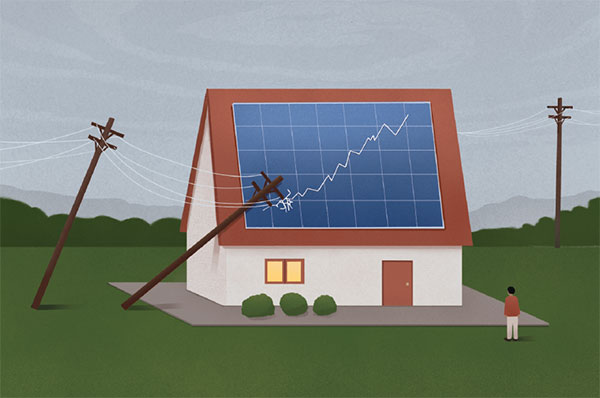
A new paper by Assistant Professor of Management Science Fariba Mamaghani investigates the impact of growing solar power adoption on electricity prices.
The rise of solar power may be a boon to the environment, but it’s creating financial headaches for utility companies and consumers. A new research paper from Fariba Mamaghani, assistant professor of management science, explores this complex dynamic, demonstrating how solar power adoption is driving up electricity prices and proposing an innovative solution to break the cycle.
As more and more homeowners install solar panels, they generate their own electricity and buy less from utility companies. While consumer solar adoption is good for the environment, it reduces the revenue that utilities generate from consumers. To make up for the shortfall, utilities raise electricity prices, which in turn pushes more people to switch to solar, further decreasing demand for utility-provided power. This “utility death spiral” can lead to skyrocketing prices for consumers and financial instability for utility companies.
“Utilities are in a difficult position,” says Mamaghani. “Growing solar adoption reduces demand, and the utilities also have to purchase the extra electricity produced by solar consumers at a premium. For example, they pay about 4 cents per kilowatt to purchase electricity on the wholesale market, but they have to purchase the extra electricity from solar customers at the retail rate, which is 10–12 cents per kilowatt. The only way they can cover their costs is to increase electricity prices.”
This isn’t just a problem for the utilities. Mamaghani says it also impacts consumers who can’t afford solar panels or don’t have the option to install them, such as apartment dwellers. These consumers end up bearing the brunt of higher electricity prices.
To break the cycle, Mamaghani and co-author Metin Çakanyıldırım propose new pricing models, including a reduced buyback rate for purchasing excess solar power and a subscription fee for solar users. These strategies aim to spread the costs more evenly between those who generate solar power and those who don’t.
“Since solar customers are using the utilities’ transmission lines both to import and export electricity, charging them a subscription fee can help the utilities cover their fixed costs without unfairly increasing prices for everyone,” Mamaghani explains.
The study also examines the role of government subsidies and regulatory policies in the solar market. While subsidies have successfully encouraged solar adoption, they can unintentionally clash with efforts to keep electricity prices affordable. Mamaghani argues that regulators need to adopt flexible pricing strategies to accommodate the growing use of solar power.
One of the study’s key insights is finding the right balance for the buyback price and subscription fee to slow or stop the utility death spiral. By carefully setting these rates, utilities can stabilize their revenues without overburdening non-solar consumers, a balance that’s crucial for maintaining both the financial health ofutilities and the affordability of electricity.
Mamaghani says she hopes her paper offers a fresh perspective on one of the biggest challenges and opportunities in the evolving energy market.
“As solar power becomes more widespread, research like this will be essential for policymakers and industry leaders looking to create a sustainable and fair energy system,” she says. “In the face of rising prices and shifting dynamics, innovative regulatory approaches are needed to ensure that the benefits of solar power can be enjoyed by all without jeopardizing the economic stability of utility companies or the affordability of electricity for consumers.”
Mamaghani’s paper, “Harvesting Solar Power Foments Prices in a Vicious Cycle: Breaking the Cycle with Price Mechanisms,” co-authored with Metin Çakanyıldırım, was published in Operations Research in December 2023.

